[Oct. 13 is International Day for Disaster Risk Reduction (DRR) ] Interview with TAKEYA Kimio, known as “Mr. Build Back Better” at UN negotiations: Sharing Japan’s resolute DRR knowledge with the world
2021.10.12
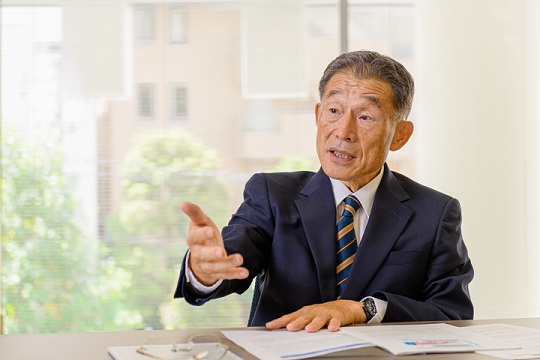
TAKEYA Kimio, Distinguished Technical Advisor on Disaster Risk Reduction at JICA. For his contributions to the field of Disaster Risk Reduction and Build Back Better, he received the Foreign Minister’s Commendations for FY 2021
“Unprecedented amounts of rainfall.” “Take action to save lives.” We recently hear more news about disasters triggered by natural hazards in Japan. Despite the increasing risk of such disasters around the world due to the additional effects of climate change, many developing countries, in particular, do not yet have sufficient disaster risk reduction measures in place. A single event of nature could directly endanger the lives of their citizens, the economic capital, and the social assets they have built up to date.
Under these circumstances, how can we make advanced preparations through investments to reduce the risk of disasters triggered by natural hazards? And how can we use the opportunity to build countries and societies that are more resilient to natural calamities when they do occur? In addressing these questions, it is essential that the philosophy of “Build Back Better” take root not only in developing countries but also globally in order to sustain countries and societies.
Leading this effort on a global scale is TAKEYA Kimio, distinguished technical advisor on Disaster Risk Reduction, JICA. What drives him is his unshakable conviction and determination born from his 40 years of experience in the field of natural disasters, working with leaders from around the world to create a “disaster-resilient society.”
* “The International Day for Disaster Risk Reduction (DRR)” was established by the United Nations as an international day to reflect on what can be done to minimize the risk of disasters triggered by natural hazards.
“Pre-disaster prevention investment is most important. Even when that is not possible, I believe that all disaster risk reduction professionals had been vaguely aware of the concept of “Build Back Better.” The idea is to use a disaster as a trigger to rebuild a more resilient society than before. Of course, it is obvious that not only rehabilitation (restoring things to their original state) but also reconstruction (restoring things to their original state and making them even stronger) is crucial. However, there had never been anyone who clearly defined Build Back Better and gained consensus in international discussions.”
At the “Third United Nations World Conference on Disaster Risk Reduction” held in Sendai, Miyagi Prefecture in March 2015, the “Sendai Framework for Disaster Risk Reduction 2015-2030” was adopted as an international framework for disaster risk reduction for the next 15 years.
As a member of the Japanese government's negotiating team, for nearly a year, Mr. Takeya strived with great persistence and enthusiasm to reach an agreement with the participants of various nations to include the importance of pre-disaster investment and, as the second-best measure, to include the definition of Build Back Better in the Sendai Framework for Disaster Risk Reduction. This is how Mr. Takeya became known as Mr. Build Back Better.

(left) Ban Ki-moon, secretary general of the United Nations (left), and Margareta Walström, special representative of the United Nations’ secretary general for Disaster Risk Reduction, who participated in the Third World Conference on Disaster Risk Reduction (*Positions are as of the date of the conference)
(right) After tough and persistent negotiations, Mr. Takeya (left) reached an agreement on the importance of pre-disaster prevention investment, and the definition and the significance of Build Back Better as the second-best measure, at the Third World Conference on Disaster Risk Reduction
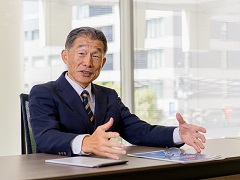
“Why Build Back Better? It is to prevent the same damage from happening again and to ensure sustainability of the overall society. Ideally, pre-disaster investment should be undertaken to prevent disasters from occurring in the first place. However, should a disaster occur before this investment, we must identify who and what industries were damaged the most by the disaster, and make the overall society more resilient based on this. It is no good just conducting a token recovery while leaving the vulnerability of society behind.”
The expertise on disaster risk reduction of Japan, one of the world's leading DRR superpowers, gives a context behind these powerful words. In Japan, about 50% of the population lives and 75% of the assets are concentrated in flood plains along rivers (areas protected by government structural prevention measures but will be inundated during floods when failed). Japan has devised a variety of measures not only to respond to floods but also to enhance the flood control level so that people can continue to live there. Even in the early post-World War II period, when the country was still impoverished, Japan continually invested in DRR, and has continued to do so to this day.
“About 75 percent of the world’s total economic damage from disasters triggered by natural hazards is caused by floods. The majority of floods occur in Asian monsoon countries such as Japan. It is the only country in the developed world that can speak about effective disaster risk reduction measures because of its understanding distinct from Western countries, where disasters triggered by natural hazards are relatively rare.”
Over nearly 40 years as a professional in the field of DRR, Mr. Takeya has been advocating the importance of Build Back Better in various roles, including as a private-sector consultant, an expert at the Asian Development Bank, and a Distinguished Technical Advisor to the President at JICA.
Among his experiences, he reflects on his involvement in the reconstruction of the Philippines after Super Typhoon Yolanda in 2013, as a member of JICA.
"Asian countries were beginning to accept the significance of Build Back Better, although there was no clear definition of the term in their disaster recovery efforts until that time. At a meeting about the reconstruction of Yolanda, JICA made the suggestion, ‘For people to have hope for the future of their country, the most important thing is to quickly outline a plan with a reconstruction philosophy to prevent similar disasters from occurring again and to rebuild a more resilient society.` Other aid agencies presented the amount of the rehabilitation budget that they could support at the meeting which was attended by national leaders. JICA’s proposal was the only one that strongly advocated the reconstruction philosophy to build a disaster-resistant society.”
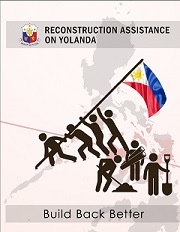
On the cover of the draft Yolanda reconstruction assistance plan, “Build Back Better” was printed as a catchphrase for the very first time, promptly after the meeting
The then-President Benigno Aquino took the importance of this issue seriously and formulated the Programme for Rehabilitation and Recovery from Typhoon Yolanda centered on Build Back Better. Subsequently, when President Rodrigo Duterte was elected, he understood that pre-disaster prevention investment was much effective than post disaster Build Back Better, and under the slogan “Build Build Build,” increased its disaster preparedness budget fivefold from 2017 to 2022, and continues to focus on proactive pre-disaster management.
“When a country's political leaders take the initiative to understand and act on the importance of pre-disaster investment, the entire country's consciousness towards disaster risk reduction changes. Today, the Philippines is the leading country of DRR in Asia.”
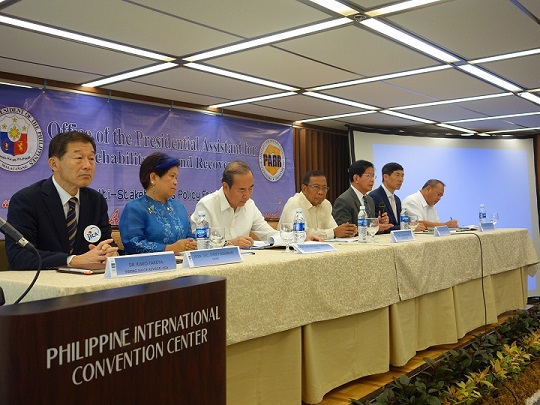
Mr. Takeya (left), one year after Typhoon Yolanda hit the Philippines, makes a presentation on the status of reconstruction alongside the vice president, minister of reconstruction, secretary of public works and highways, and other key Philippine government officials
When Typhoon Ulysses struck the metropolitan Manila area in 2020, it was estimated that advanced flood control measures were successful in reducing the flooded area and economic damage by 85%.
One cannot deny the possibility that Japan too will experience unprecedented disasters in the future. Many people may think of disasters as somebody else’s problem, owing to the fact that they were able to avoid damage thanks to the pre-disaster investments that have been made by former generations. However, it is time for us to consider once again what should be done to create a more resilient society in preparation for the future disasters.
Based on the Sendai Framework for Disaster Risk Reduction, each nation has accelerated its development of national and local DRR strategies that include pre-disaster investment over the five-year period from 2015 to 2020.
“Not all developing countries have finalized their disaster prevention plans. JICA is taking up the role to cooperate in the formulation of DRR plans to identify whether it is possible to make systematic investments to prevent a decline in GDP in the event of a disaster. Looking back on Japan's DRR initiatives, we cannot affirm that all the policies were 100% correct. It is important to combine Japan's DRR technologies with the counterpart country’s needs and formulate the right mix for each, based on its circumstances and the size of its assets.”
And from 2021, this will be an important period for each nation to implement its newly formulated DRR plans and shape a sustainable society.
“As a professional international cooperation organization, JICA is expected to have discussions with leaders in each country on the importance of pre-disaster investment and reconstruction based on the philosophy of Build Back Better. JICA must show the path to building a more disaster-resistant society.”
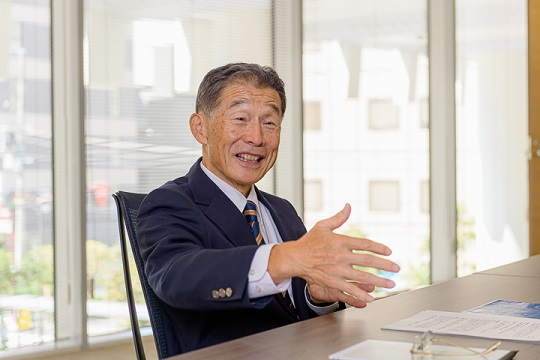
TAKEYA Kimio, distinguished technical advisor to the president, JICA
Mr. Takeya has served as president of a private consulting firm, senior specialist in Water Disaster Management, Sustainable Development Department, Asian Development Bank, and JICA Distinguished Technical Advisor to the President. He also teaches as a visiting professor at the Tohoku University International Research Institute of Disaster Science (IRIDeS). In high school, he played soccer, winning the National High School Soccer Championship and representing Japan in the U20 Asian Games. This autumn, if circumstances permit, he is planning a bicycle tour of the areas affected by the Great East Japan Earthquake with his students. A native of Kyoto City.
scroll